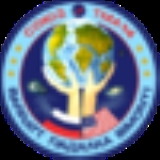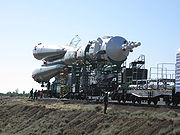
Soyuz TMA-15
Encyclopedia
Soyuz TMA-15 was a manned spaceflight
to the International Space Station
. Part of the Soyuz programme
, it transported three members of the Expedition 20
crew to the space station. TMA-15 was the 102nd manned flight of a Soyuz spacecraft, since Soyuz 1
in 1967. The Soyuz spacecraft remain docked to the space station during Expedition 20 and Expedition 21
as an emergency escape vehicle. The mission marked the start of six-person crew operations on the ISS.
 Soyuz TMA-15 was launched successfully by a Soyuz-FG
Soyuz TMA-15 was launched successfully by a Soyuz-FG
carrier rocket
from Site 1/5
at the Baikonur Cosmodrome
in Kazakhstan
, at 10:34 UTC on 27 May 2009. It docked with the ISS at 12:34 UTC on 29 May 2009.
Roman Romanenko
was the third second-generation space traveller. He was reported to have chosen Taymyr
as the mission callsign because it was the callsign on his father's
first flight, Soyuz 26
; however, the callsign Parus ( meaning Sail
) was used for communications with the spacecraft. Robert Thirsk became the first Canadian to fly on a Soyuz; all previous Canadians in space had flown aboard Space Shuttle
s. Frank De Winne
became the first West-European to be in command of the ISS.
The craft and crew returned to earth 1 December 2009.
Human spaceflight
Human spaceflight is spaceflight with humans on the spacecraft. When a spacecraft is manned, it can be piloted directly, as opposed to machine or robotic space probes and remotely-controlled satellites....
to the International Space Station
International Space Station
The International Space Station is a habitable, artificial satellite in low Earth orbit. The ISS follows the Salyut, Almaz, Cosmos, Skylab, and Mir space stations, as the 11th space station launched, not including the Genesis I and II prototypes...
. Part of the Soyuz programme
Soyuz programme
The Soyuz programme is a human spaceflight programme that was initiated by the Soviet Union in the early 1960s, originally part of a Moon landing project intended to put a Soviet cosmonaut on the Moon...
, it transported three members of the Expedition 20
Expedition 20
Expedition 20 was the twentieth long-duration flight to the International Space Station. The expedition marked the first time a six-member crew inhabited the station...
crew to the space station. TMA-15 was the 102nd manned flight of a Soyuz spacecraft, since Soyuz 1
Soyuz 1
Soyuz 1 was a manned spaceflight of the Soviet space program. Launched into orbit on April 23, 1967 carrying cosmonaut Colonel Vladimir Komarov, Soyuz 1 was the first flight of the Soyuz spacecraft...
in 1967. The Soyuz spacecraft remain docked to the space station during Expedition 20 and Expedition 21
Expedition 21
Expedition 21 was the 21st long-duration mission to the International Space Station . The expedition began on 30 September 2009, with Frank de Winne becoming the first ESA astronaut to command a space mission....
as an emergency escape vehicle. The mission marked the start of six-person crew operations on the ISS.
Crew
Backup crew
Mission highlights

Soyuz-FG
The Soyuz-FG launch vehicle is an improved version of the Soyuz-U, from the R-7 family of rockets, designed and constructed by TsSKB-Progress in Samara...
carrier rocket
Launch vehicle
In spaceflight, a launch vehicle or carrier rocket is a rocket used to carry a payload from the Earth's surface into outer space. A launch system includes the launch vehicle, the launch pad and other infrastructure....
from Site 1/5
Gagarin's Start
Gagarin's Start is a launch site at Baikonur Cosmodrome in Kazakhstan, used for the Soviet space program and now managed by the Russian Federal Space Agency....
at the Baikonur Cosmodrome
Baikonur Cosmodrome
The Baikonur Cosmodrome , also called Tyuratam, is the world's first and largest operational space launch facility. It is located in the desert steppe of Kazakhstan, about east of the Aral Sea, north of the Syr Darya river, near Tyuratam railway station, at 90 meters above sea level...
in Kazakhstan
Kazakhstan
Kazakhstan , officially the Republic of Kazakhstan, is a transcontinental country in Central Asia and Eastern Europe. Ranked as the ninth largest country in the world, it is also the world's largest landlocked country; its territory of is greater than Western Europe...
, at 10:34 UTC on 27 May 2009. It docked with the ISS at 12:34 UTC on 29 May 2009.
Roman Romanenko
Roman Romanenko
Roman Yurievich Romanenko is a cosmonaut at the Yu.A. Gagarin Cosmonaut Training Center.-Personal life:His parents, Yuri Victorovich Romanenko and Aleftina Ivanovna Romanenko, live in Star City. He is married to Yulia Leonidovna Romanenko . They have one son...
was the third second-generation space traveller. He was reported to have chosen Taymyr
Taymyr Peninsula
The Taymyr Peninsula is a peninsula in the Far North of Russia, in the Siberian Federal District, that forms the northernmost part of mainland Eurasia and Asia...
as the mission callsign because it was the callsign on his father's
Yuri Romanenko
Yury Viktorovich Romanenko is a former Soviet cosmonaut, twice Hero of the Soviet Union . Over his career, Yury Romanenko spent a total of 430 days 20 hours 21 minutes 30 seconds in space and 18 hours in space walks. In 1987 he was a resident of the Mir space station, launching on Soyuz TM-2 and...
first flight, Soyuz 26
Soyuz 26
Soyuz 26 was Soviet manned mission, used to launch the crew of Salyut 6 EO-1, the first long duration crew on the space station Salyut 6.The Soyuz spacecraft was launched on December 10, 1977, and docked with the space station the next day...
; however, the callsign Parus ( meaning Sail
Sail
A sail is any type of surface intended to move a vessel, vehicle or rotor by being placed in a wind—in essence a propulsion wing. Sails are used in sailing.-History of sails:...
) was used for communications with the spacecraft. Robert Thirsk became the first Canadian to fly on a Soyuz; all previous Canadians in space had flown aboard Space Shuttle
Space Shuttle
The Space Shuttle was a manned orbital rocket and spacecraft system operated by NASA on 135 missions from 1981 to 2011. The system combined rocket launch, orbital spacecraft, and re-entry spaceplane with modular add-ons...
s. Frank De Winne
Frank De Winne
Frank, Viscount De Winne is a Belgian Air Component officer and an ESA astronaut. He is Belgium's second person in space . He was the first ESA astronaut to command a space mission when he served as commander of ISS Expedition 21.-Education:De Winne graduated in 1979 from the Royal School of Cadets...
became the first West-European to be in command of the ISS.
The craft and crew returned to earth 1 December 2009.

